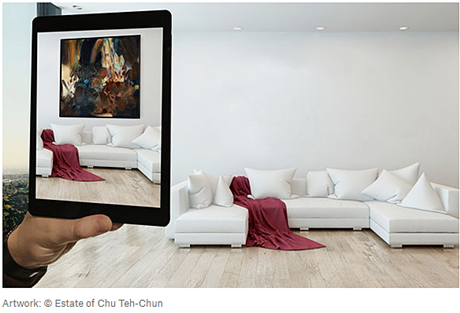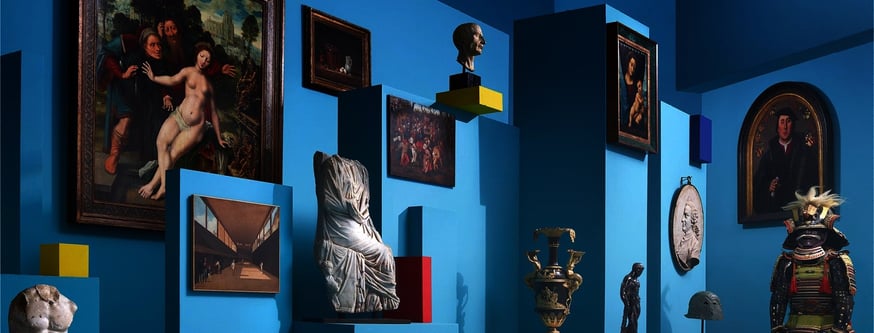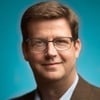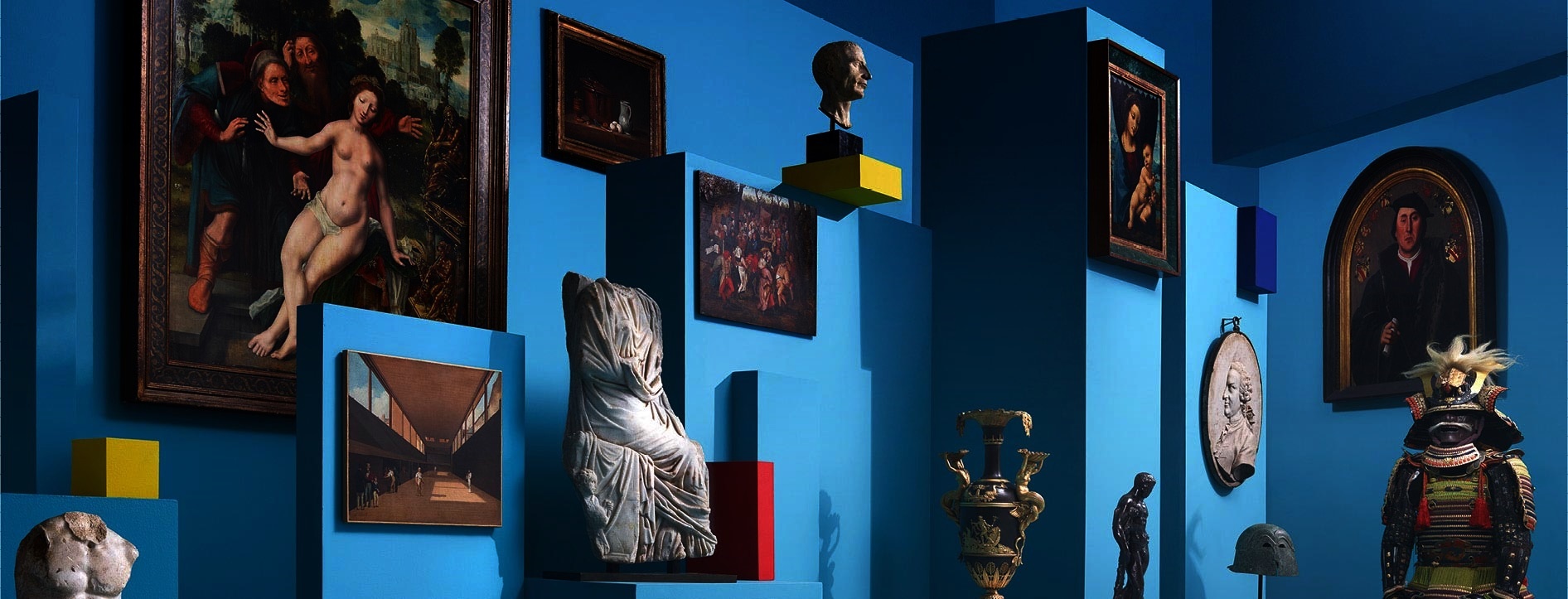Images courtesy of Christie's Inc.
Steve Rovniak: Were you actively looking for a new CIO role?
 Richard Entrup: Yes, I was actively looking. I had recently left Disney/ABC TV Group where I managed the Media Technology Group in support of the ABC TV Network and the Disney Channels Worldwide. The leadership team wanted me to relocate to Los Angeles to be closer to executive management and my internal business clients, but I decided to decline for personal reasons. Disney is an amazing brand and company, so it was not an easy decision, but family comes first.
Richard Entrup: Yes, I was actively looking. I had recently left Disney/ABC TV Group where I managed the Media Technology Group in support of the ABC TV Network and the Disney Channels Worldwide. The leadership team wanted me to relocate to Los Angeles to be closer to executive management and my internal business clients, but I decided to decline for personal reasons. Disney is an amazing brand and company, so it was not an easy decision, but family comes first.
Were you looking for a CIO role specifically?
Not exclusively. I would have entertained a number two position provided it was a big enough company or IT department. I was actually in play for number two roles at a large media company and a medical data company. Rather than limit my search to CIO-only roles, for me it’s more about the quality and culture of the company, the brand, my passion for the industry, the nature of the work, and most importantly, the opportunity to make a positive impact on the business. It’s all very relative.
How did you hear about the CIO opportunity at Christie’s?
After deciding that I would not be moving to LA with Disney/ABC, I started a formal job search. That was September of 2016. On October 13th, the Wall Street Journal ran a piece about how Christie’s was searching for a new CIO. I was very interested in the company, the role, as well as returning to the art business, so I engaged with Christies HR in London right away. I accepted an offer a week before Christmas.
What piqued your interest in the position?
Getting back to the art business for starters. Earlier in my career, I was Technology Director at The Museum of Modern Art (MoMA) in New York, which was a great experience. I have always been an art enthusiast, and I love photography, painting, and drawing. I also liked that it was a global role, reported to the Deputy CEO, and that they were interested in attracting new clients and enhancing the customer experience using digital technology, which was in my wheelhouse. I’ve had the honor of working for many amazing brands in my career that were all focused on the customer experience, so I felt I could really contribute to the business and make a measurable impact. It’s truly an exciting and unique business.
Unlike traditional luxury retail, everything Christie's sells, whether at auction, online or via a private sale, is a one-of-a-kind work of art or luxury item. Categories include fine art, decorative arts, rare watches, jewelry, fine wine and luxury handbags. I think as an employee, you can’t help but get excited and appreciate the privilege of seeing amazing art and objects, many of which will be sold to private collectors and never be seen again.
Speaking of amazing items, you may have heard that we recently sold a Leonardo da Vinci painting for $450 million, which smashed all kinds of records. Last summer, we also announced that Christie’s had been entrusted to sell the personal collection of Peggy and David Rockefeller to raise funds for select philanthropies. This collection represents the most significant philanthropic auction of our time.
What was Christie’s looking for in their new CIO?
Christie’s wanted a blend of talent and experience that included global IT operations management, strong client engagement skills, digital experience, eCommerce, information security, and IT strategy. They were looking for a strong technology leader who could quickly connect with the business stakeholders and manage a high-caliber global IT team. While not stated as a core requirement, I also suspect my genuine passion for art and media also helped my candidacy.
Did you have an interview strategy?
Absolutely. I immediately began researching the company and the industry. I also registered on Christie’s website and began experiencing the company as a client. I also conducted a consignment valuation request. This ensured a quality interview process where I could speak about what was working, and where things could improve.
My strategy was to keep the conversation focused on the future and what I could do for the company. Career history and academic credentials are important, but they don’t always win the job. They’re also not predictive of success. You want to present solutions to real problems during the interview process to demonstrate thought leadership, problem-solving skills, and a passion for excellence.
What else did you do to prepare for your interviews?
I checked LinkedIn and my network to identify current or previous employees of either Christie’s or their competitors, and reached out for their perspective on the industry, the company, and the culture. In the process, I actually connected with a former CIO from Sotheby’s, our largest competitor, who had left the company many years prior but was able to provide me with valuable information on the industry and its major challenges and opportunities, as well as the culture I could expect. These conversations really helped me create a tight message around my value proposition and differentiating skills that I brought to the table, and a vision for what I could contribute as the Global CIO.
How did you prepare to start your new role?
I continued with a lot of research into the company and the industry, and I continued to experience Christie’s as much as I could online as a customer. The Christie’s HR team was fantastic and ensured that I was equipped with a comprehensive onboarding package with information about the company, the executives, and the IT team. This truly helped me assimilate quickly and hit the ground running.
I also visited the office a week prior to my start date to meet with the team and have lunch with my direct reports. Then I started to frame up the first 90 days, like I have done every time I started a new role.
How did you go about that exactly?
I go back to that Harvard Business Review book, The First 90 Days (by Michael D. Watkins) every time. It is such a great resource—it reminds me about what to look for, how to identify my quick wins, and recognize my biggest supporters early on. It’s a great tool for any new leader, in any role.
Who do you report to at Christie’s?
The Deputy CEO.
How did you learn the business and build relationships?
I have a very formal approach, and relationships are key. I focus on people, process and technology, which is a traditional framework. I also focus on finance/budget and risk/compliance, which includes information security. You must get your arms around these areas quickly.
First was the people: this includes an understanding of various departments, peers, senior leaders, my manager, his peers, my team, and many others to quickly understand who does what and how things operate. I also connected with our specialists from various clusters to understand their needs. You need to learn the political dynamics and how decisions are made and you need to establish mentors and trusted advisors quickly to help you navigate the new landscape. I inherited a solid IT organization made up of very hard working and dedicated technical professionals who were ready to be challenged and empowered to reconnect with the business in a new and refreshed way.
Second was process: you need to assess the IT maturity levels from a process perspective. Is software/product development Agile or Waterfall? If and how are metrics used? Are there SLAs? What are the governance models and how are decisions made, not just in IT, but across the entire business? You need to assess the overall process maturity model and appetite for process engineering improvements.
Third is technology. There are many questions to answer when first conducting a baseline assessment: What is the maturity level and roadmap of major platforms? Open source vs proprietary vendor stacks? Are things built for scale and performance? Who handles UI/UX and how is user adoption measured? How is vendor management handled for SaaS solutions? What is the SDLC / software development capability and velocity? How is software engineering performance measured? Tools and processes? What is the application modernization level? Is the team using DevOps, Cloud, Virtualization ratios, etc.? Also, what is the data strategy and how is data governance handled? Finally, is there an R&D group in IT looking at emerging technology and how IT can enable new business models and revenue streams? The tech assessment list is much longer than this, but those are some of the key areas.
Audio-visual (AV) also falls within my group and needed to be assessed. It’s an important area since we support many live sales and special events all over the world, so uptime is critical.
Next is information security, risk and compliance. I assessed the cybersecurity maturity level as well as incident prevention, detection and response capabilities. I swiftly hired a Head of Information Security to assist with policies, tools, compliance, and monitoring to raise our IT security levels and protect sensitive data.
Finally, I quickly gained a handle on IT finances and budgeting. I established a relationship with my Finance partners, assessed historic opex to capex spend by region, by IT function, T&E, strategic sourcing for cost savings opportunities, and assessed all other IT costs. I also completed the 2017 budget cycle within my first few weeks onboard, which was very helpful with understanding what I had to work with financially.
Did you find that anything that was 'on fire' and needed to be dealt with right away?
Given our goals in the area of online sales and the client experience, the digital organization needed a refresh. The CMO and I worked very closely to address this challenge. We have made many changes and we both oversee “digital," with input from the business and senior leadership. This may come to a surprise to many of my fellow CIOs since there are so many stories about the conflict between the CIO and CMO, but I believe our collaboration is a success story.
From a Digital perspective, the CMO has social media, digital marketing, SEO/SEM, content, etc. and my team has all the underlying technology that supports it, including Online Sales and Christie’s LIVE™. There are gray areas like UI/UX, navigation, search, personalization, data taxonomy, etc., but we all work through them in harmony. We also created a new Head of Digital Experience role, who has a straight line to me and a dotted line to the CMO, which has also worked out well. It’s a great team and we’re all aligned and focused on enhancing the client experience digitally.
What is Christie’s doing with the customer experience using digital?
We are always exploring ways of enhancing the customer experience through digital technology. The website, our mobile app, Christie’s LIVE™, and our Online auction platforms have also been very successful in support of engagement, conversion and attracting new clients. The Christie’s Marketing team has been creating some amazing content for our social media sites like Facebook and Instagram and they also launched a 360-View experience that let’s you walk the galleries before a sale, no matter where it is in the world.
We also recently launched a Christie’s augmented reality (AR) feature on our mobile App. When browsing through works of art in a sale, you can see what something looks like in the context of your home.  We also have Christie’s LIVE™, which let’s you view and bid in live auctions from your computer or via mobile web. We also stream our major sales on Facebook Live and our website. Over 100,000 people watched our Post-War Evening sale in November on Facebook Live and the post-sale press video on the sale of the Leonardo da Vinci work is still trending and has been seen over two million times, which are unprecedented stats for us.
We also have Christie’s LIVE™, which let’s you view and bid in live auctions from your computer or via mobile web. We also stream our major sales on Facebook Live and our website. Over 100,000 people watched our Post-War Evening sale in November on Facebook Live and the post-sale press video on the sale of the Leonardo da Vinci work is still trending and has been seen over two million times, which are unprecedented stats for us.
These digital capabilities all afford the opportunity to experience the art in completely new ways, and there is much more to come as we explore how to leverage emerging technology to enhance the client experience and Christie’s overall business digitally. It’s the best way to attract new clients.
What else have you been working on over the past 12 months?
We have implemented new governance models to ensure that everything IT works on is aligned to strategic business goals. We’re always enhancing our digital platforms like our website and mobile App, and we’ve been building an Object Intelligence system that will allow our Specialist teams to research objects and connect buyers and sellers. We’re also always fortifying our Information Security posture and IT Infrastructure, and recently converted to a new outsourced IT Services provider which has kept the team busy.
It’s an exciting time because technology is at the foundation of almost everything going on at Christie’s in the lifecycle of an object or a client. The IT and Digital teams all have the opportunity to support and enable the business in so many ways.
How do you know when your IT organization is succeeding?
To me, the ultimate acknowledgment of success as a technology business leader is having an internal consumer of IT services confirm that things are noticeably changing for the better, for them, and for their clients. I believe we are making great strides in this respect based on client feedback, in our service levels, as well as our software products, and we have much work ahead of us.
My team also recently built an internal mobile app for past and real time auction sales results, and the demand and feedback from executive pilot users has been very positive. While it’s still in beta, I get texted when it’s down or not working properly, which means we have created a product of value that people want and need. That’s success as a technologist—building great software products that people value and can’t live without.
The Consumerization of IT needs to be a priority. IT needs to build systems that people want to use and adoption shouldn’t need to be forced or mandated. UI/UX needs to be a top priority and an Agile approach will ensure proper client engagement during the build process.
If you were granted a ‘redo’ on your first 90 days, what would you do differently?
Not much, everything is going as planned. It’s art and science, and what works in one organization may not necessarily be effective in another. Building solid relationships, coalition building, a sense of urgency, transparency, financial management, governance, a passion for the business, and strong communications are all key tenets of success in any new leadership role.
What new consumer technology do you find exciting personally?
I’ve been downloading and testing a lot of 3D/augmented reality apps to gain ideas for Christie’s. I also have an Amazon Echo Dot, but I recently unplugged it since I really didn’t use it that much. But I think voice recognition will gain momentum and possibly replace keyboards and screens one day for basic interaction with the machines. I’m also keen on AI and what it will mean to business intelligence and helping businesses become more programmatic. I’m also very interested to see where Blockchain is going and how it can be used in the art world.
What is your favorite place to travel on business?
New York is my favorite city, then London and Paris. I also love San Francisco and Shanghai. Wherever there’s great energy, museums, music, and great restaurants.
Do you have an airport vice?
Yes, treating myself to a new gadget at one of those overpriced electronics dispensing machines. It gets me every time. A brilliant concept and retail POS experience.
What advice do you have for a CIO or IT leader thinking about entering today’s job market?
Differentiate yourself from the pack. Competition can be fierce, so network and use your relationships to guarantee a conversation. Even getting to that first interview step can be challenging.
Do your research and identify problems and risks of the prospective company you’re meeting with and explore potential solutions before your first interview, so the discussion is about your thought leadership, your passion, problem-solving skills, and unique value proposition, and less about your last job, your academic credentials, or what you did 20 years ago. Past experience and success are important, as are references and recommendations, but they’re not always predictive of future success.
There are way too many dynamics at play from one company to the next, however, every company in every industry has the same technology challenges, so you can be effective anywhere. Having a true passion for the business will make you stand out and be that much more successful. Most importantly, have fun and do what you love, so it never feels like work!
About Richard Entrup
Richard Entrup is the Global Chief Information Officer of the global art auction company, Christie’s, Inc. Prior to Christie’s, he held various technology leadership roles at prominent global brands including Disney/ABC TV Group, Time Warner Inc., The Museum of Modern Art (MoMA), Viacom, and Tiffany & Company. Entrup also served as CIO at a major global law firm and several healthcare companies with documented success aligning technology investment to strategic business objectives. A passionate advocate of continuing education, mentoring, and paying it forward, Entrup is an active mentor to students enrolled in the Executive Master of Science in Technology Management Program at Columbia University and a Taproot Foundation Pro Bono Advisor to non-profits via the Disney VoluntEARS program.


Written by Steve Rovniak
Steve Rovniak served as Executive Director, Marketing and Media at Heller Search Associates from 2012 to 2023.



